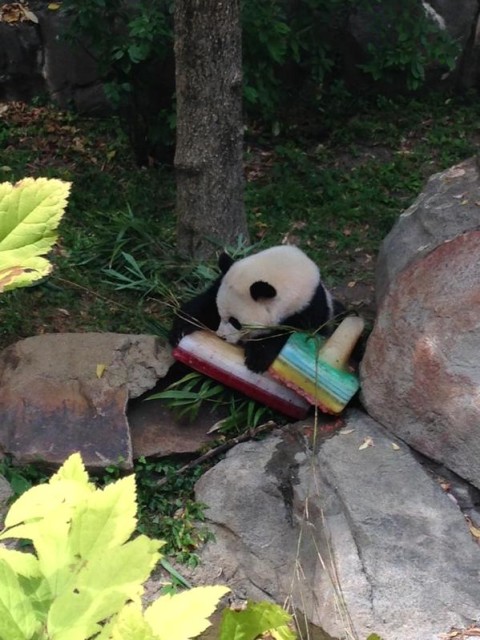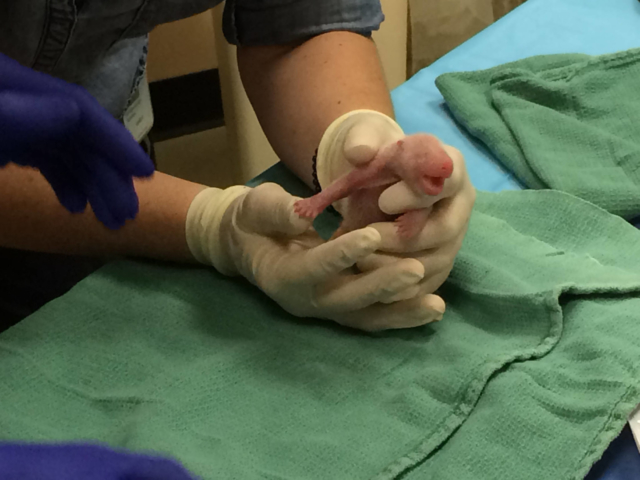In more than three decades of trying to breed pandas at the National Zoo, there’s been plenty of heartbreak. More cubs born in Washington have died than survived, and news of a birth has often been greeted warily.
But on Sunday, zoo officials were nearly giddy. They don’t just have an apparently healthy pair of twins, born about 5 hours apart on Saturday to panda mom Mei Xiang. They have a template to follow that gives the cubs a strong chance of survival.
Pandas won’t usually nurse twins if left to their own devices. They’ll care for one and allow the other to die. But in the past decade, Chinese breeders have come up with a system: Every several hours, they swap out the cubs, giving each one the critical time it needs to nurse and bond with its mother. Meanwhile, the other one is bottle fed and kept warm in an incubator.
The strategy aims to reduce the burden on the mother while allowing both cubs equal time nursing.
“Swapping them out definitely increases the survival. Part of it is that it’s a lot for one female to take care of. There have been two females internationally under human care who have successfully raised two cubs at the same time. It was a pretty intensive process for both individuals,” Copper Aitken-Plamer, chief veterinarian at the Smithsonian Conservation Biology Institute, told a press conference on Sunday morning.
Shortly after the birth of the second cub, panda keepers retrieved one of the cubs and placed it in an incubator. They fed the newborn cub, which weighed 132.4 grams, with serum collected from Mei Xiang to help it obtain some key antibodies.
Our giant panda cubs are doing well but we had a challenging night swapping cubs w Mei. Had to supplement feed 1 cub pic.twitter.com/XnOu5P9ABB
— National Zoo (@NationalZoo) August 24, 2015
At approximately 06:30 on Sunday, the panda team was able to swap the cubs. The cub believed to be the first born, weighing 86.3 grams, was taken away after spending more than ten hours with the mother.
Giant panda Mei Xiang giving birth to first cub on Aug. 22, 2015
Panda keepers at the Smithsonian’s National Zoo will continue performing these delicate swaps as long as it’s needed and as long as Mei Xiang lets them. By late Sunday afternoon, the twins had traded places three times without incident, with Mei Xiang cradling them in turn.
“If she gets aggressive toward us, we’re not going to get that close,” giant panda biologist Laurie Thompson said Sunday.
Mei Xiang giving birth to second cub about 5 hours later
The swapping technique helped twin pandas born two years ago at Zoo Atlanta to survive. That was the second set of panda twins born in the United States. The first, born at the National Zoo in 1987, both died within days.
Scientists in China have learned much more about panda breeding since then. Two decades ago, the survival rate for panda cubs was under 20 percent. Now, it’s more than 80 percent, zoo director Dennis Kelly said.
“We’ve all been involved in events that don’t go so well, so we are ecstatic that things are going great,” said Don Neiffer, the zoo’s chief veterinarian.
ORIGINS OF SWAPPING TECHNIQUE
The Chengdu Research Base of Giant Panda Breeding in Sichuan, China published a twin cub-rearing study decades ago that detailed the method for raiding panda twins for the first time in history and increasing the survival rate of giant panda cubs to from 37 percent to 67 percent in the 1990s.
The survival rate of twins grew to 90 percent after the development of collecting colostrum in 2006, milk from mammals in late pregnancy, through domestication to ensure there was enough to feed the baby pandas.
Mei Xiang Ultrasound Video Clip
Nursing twins doesn’t appear to come naturally to pandas, which are endangered, with roughly 1,800 living in the wild and 350 in captivity.
“It’s very rare, obviously, for them to manage two cubs. If she were able to do it, we would certainly let her,” Thompson said. “She couldn’t figure out how to hold both of them. She couldn’t get ahold of one and have the other one under her arm and pick it up at the same time. She just kept fumbling with them.”
Giant Panda Mei Xiang Ultrasound
The cubs have squealed loudly when taken away from Mei Xiang — one of several signs that they are strong and healthy. Although one weighed in at roughly 4 ounces (113 grams) and the other was just 3 ounces (85.05 grams) at birth, both are considered within the healthy weight range. They are blind, and pink in color, with wispy white fur.
The second cub was given a serum drawn previously from Mei Xiang’s blood because it hadn’t gotten a chance to nurse. Keepers are prepared to bottle-feed the cubs if necessary, but they won’t do it unless one of the pandas is underweight or has other health problems.
PARTY OF FIVE
Mei Xiang has given birth to two surviving cubs: Tai Shan, a male born in 2005, and Bao Bao, who turned 2 on Sunday and put on a show for hundreds of delirious panda watchers as she devoured her “birthday cake”: a frozen concoction made with honey, apples, carrots and bamboo.
Ling-Ling and Hsing-Hsing, the panda pair lent to the United States by China after Richard Nixon’s historic visit in 1972, successfully mated five times, but none of the cubs lived longer than a few days.
Watch the zoo’s panda cams
Mei Xiang gave birth to a cub in 2012 that died after six days.
The new additions mean that for the first time the zoo has five pandas in residence. In addition to Bao Bao, Mei Xiang and the new cubs, the zoo is also home to an adult male panda named Tian Tian. In the past, the zoo has never had more than three pandas at one time.
Tian Tian is the father of Mei Xiang’s previous cubs. This time, she was artificially inseminated with semen from Tian Tian and another panda in China that was determined to be a good genetic match. If that panda turns out to be the father of one or both cubs, it would benefit the species’ genetic diversity, zoo officials said.
Mei Xiang was artificially inseminated in April with fresh sperm from panda Tian Tian at the zoo, and frozen sperm from another panda Hui Hui, from a research base in China.
“The Wolong Breading Center is considered one of the largest breeding centers in China for giant pandas. We’ve worked with Wolong for decades and we’ve worked very closely for developing the science behind artificial insemination, timed off of hormones, as well as what we known about behavior. We have worked with our Wolong colleagues and Wolong scientists. They’ve come here to work with us to get Mei Xiang pregnant,” said Aitken-Plamer.

Bao Bao celebrated her 2nd birthday at the National Zoo, just one day after her new twin siblings were born.
The identity of the cubs’ father remains unknown, but DNA analysis will soon provide the answer.
“Actually it is possible that the babies could have two separate fathers, because we used not only the semen from the panda from China, but we also used our own Tian Tian’s semen. So it is possible if two eggs were fertilized that there could be two different fathers,” said Laurie Thompson, a giant panda biologist.
There’s no timetable for performing genetic testing, and zoo officials said it will be three to four weeks before their genders are known. The cubs won’t be named until they are 100 days old, per Chinese tradition.
Bao Bao didn’t make her public debut until she was 5 months old, but the cubs and Mei Xiang will be visible on the zoo’s popular “Panda Cam” livestream.
Over the next few weeks, zoo staffers hope to develop a routine for swapping the cubs and monitoring their growth.

Giant Panda Mei Xiang, sleeps in the indoor habitat at the Smithsonian’s National Zoo. Wednesday, Aug. 12, 2015 just a few weeks before she gave birth to two twin pandas. (AP Photo/Jacquelyn Martin)
“A lot of things have to happen. This is a very critical period,” Neiffer said. “Until the cubs are both out walking around, acting normal, being a panda, that’s probably when we’ll exhale.”
Giant pandas, one of the world’s most endangered species, have a very low reproductive rate. There are about 1,600 giant pandas known to be living in the wild and some 300 in captivity, mostly in China.
Story by the Associated Press
 CGTN America
CGTN America Mei Xiang’ second retrieved cub. (Photo Credit: Pamela Baker-Masson, Smithsonian’s National Zoo)
Mei Xiang’ second retrieved cub. (Photo Credit: Pamela Baker-Masson, Smithsonian’s National Zoo)
